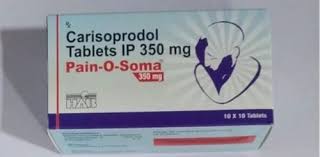Introduction
Carisoprodol is a medication used as a muscle relaxant and for the treatment of musculoskeletal conditions. This article provides a comprehensive overview of carisoprodol, including its mechanisms of action, clinical applications, and safety considerations.
Mechanisms of Action
pain o soma 500 mg (Carisoprodol’s) mechanism of action is not fully understood, but it is believed to exert its effects by acting as a centrally acting skeletal muscle relaxant. It likely works by altering interneuronal activity in the descending reticular formation and spinal cord. Additionally, carisoprodol may potentiate the effects of GABA, a neurotransmitter that inhibits nerve transmission in the brain and spinal cord.
Clinical Applications
Muscle Relaxation
pain o soma 350 mg (Carisoprodol) is primarily used for the relief of discomfort associated with acute, painful musculoskeletal conditions. It is often prescribed for short-term use, typically for two to three weeks, as an adjunct to rest, physical therapy, and other measures for the relief of acute, painful musculoskeletal conditions.
Pain Management
In addition to its muscle relaxant properties, carisoprodol may also have analgesic effects, helping to alleviate pain associated with musculoskeletal conditions. However, its efficacy as a standalone pain reliever is limited, and it is usually prescribed in combination with other analgesic medications.
Clinical Efficacy
Clinical studies have demonstrated the efficacy of carisoprodol in providing symptomatic relief of acute, painful musculoskeletal conditions. However, its use beyond two to three weeks is not recommended due to the risk of tolerance, dependence, and withdrawal symptoms.
Safety Considerations
Tolerance, Dependence, and Withdrawal
Prolonged use of carisoprodol can lead to the development of tolerance, dependence, and withdrawal symptoms upon discontinuation. It is classified as a Schedule IV controlled substance in the United States due to its potential for abuse and dependence.
Central Nervous System Effects
Carisoprodol can cause drowsiness, dizziness, and impaired cognitive and motor function, which may impair the ability to perform activities requiring mental alertness, such as driving or operating machinery. Patients should be advised to avoid alcohol and other central nervous system depressants while taking carisoprodol.
Abuse Potential
Carisoprodol has the potential for abuse, particularly among individuals with a history of substance abuse or addiction. Misuse of carisoprodol can lead to physical and psychological dependence, overdose, and death.
Renal and Hepatic Impairment
Patients with renal or hepatic impairment may require dosage adjustments or closer monitoring while taking carisoprodol due to the potential for accumulation of the drug and its metabolites.
Pregnancy and Lactation
The safety of carisoprodol use during pregnancy and lactation has not been established, and its use is generally not recommended in these populations unless the potential benefits outweigh the risks.
Conclusion
Carisoprodol is a centrally acting skeletal muscle relaxant used for the relief of acute, painful musculoskeletal conditions. While it is effective for short-term use, its long-term use is associated with the risk of tolerance, dependence, and withdrawal. Patients should be counseled on the potential risks and benefits of carisoprodol therapy, and its use should be closely monitored to minimize the potential for abuse and adverse effects.





